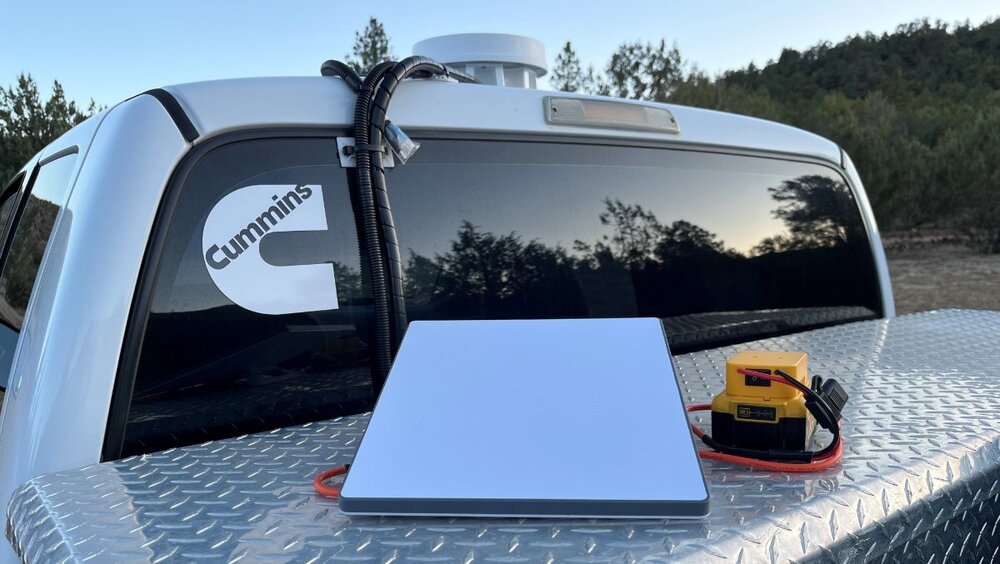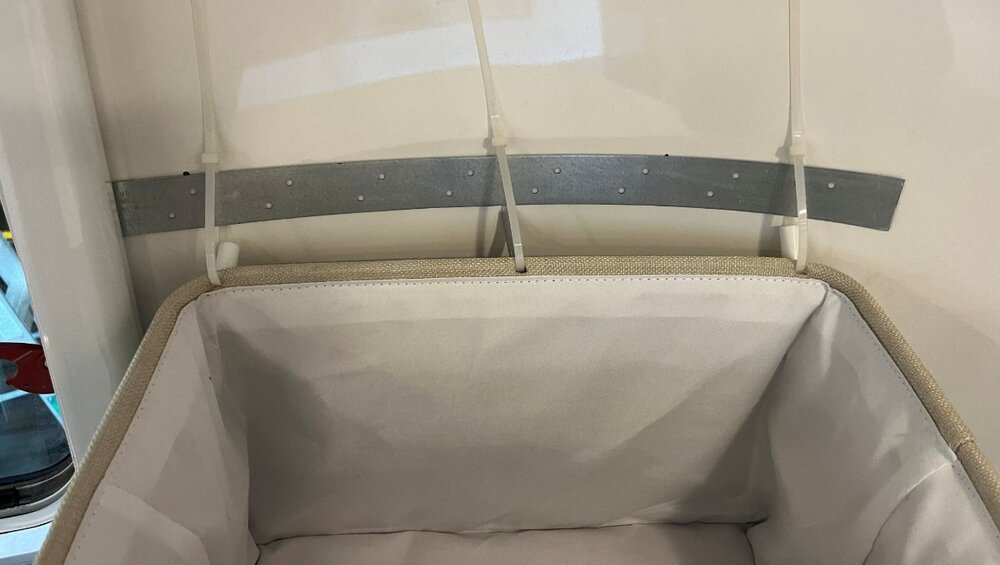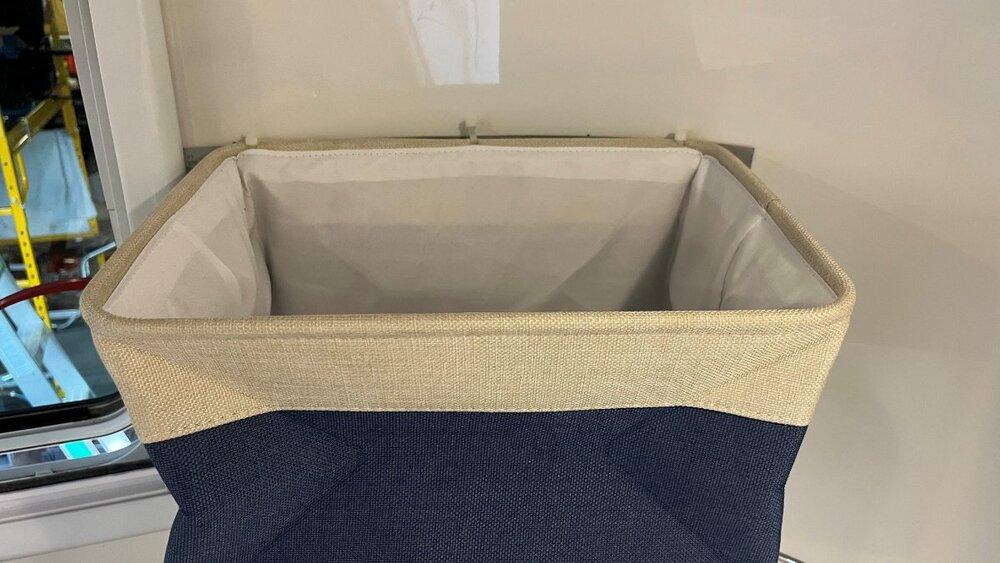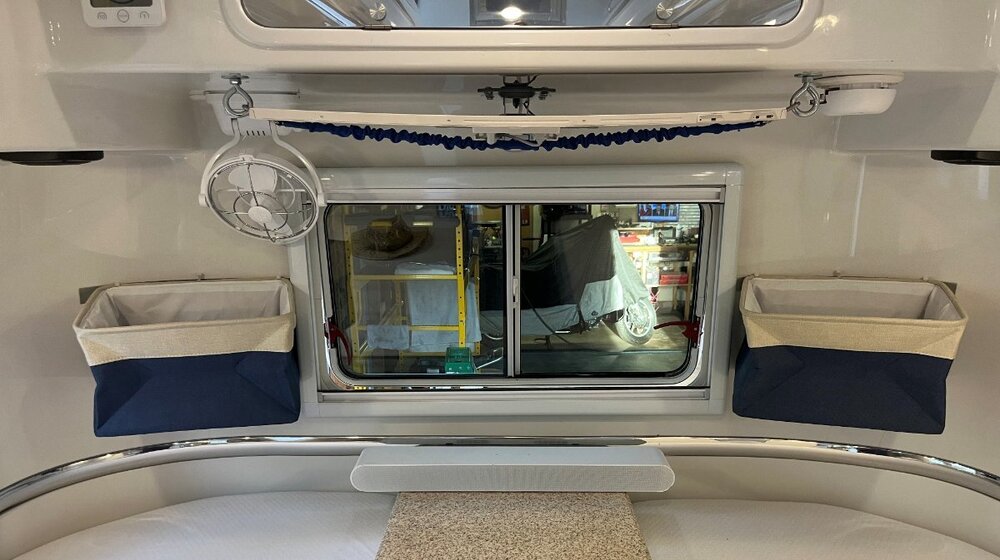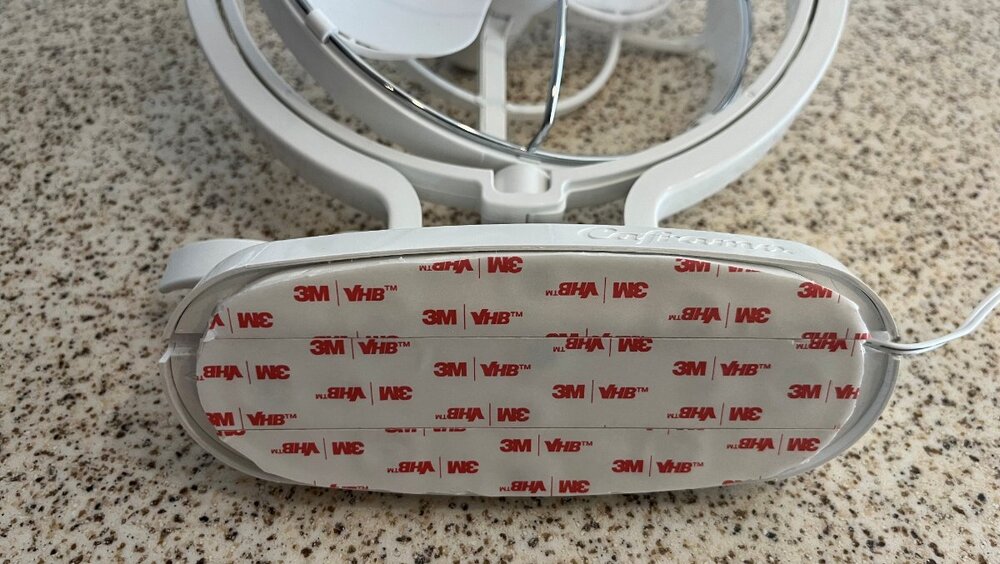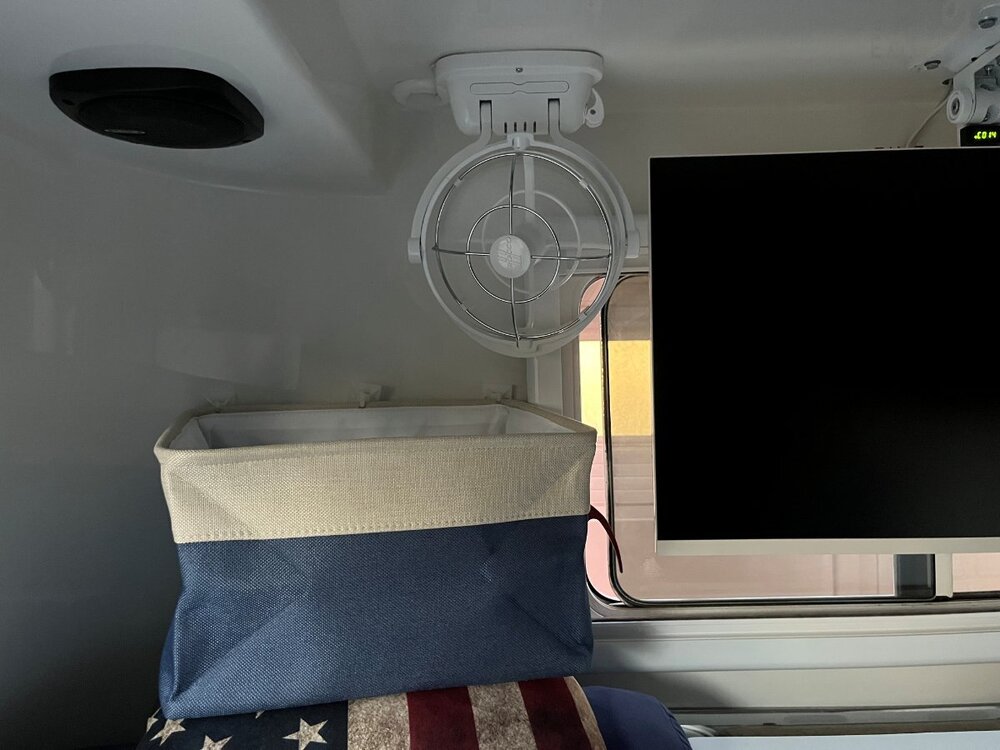-
Posts
2,954 -
Joined
-
Last visited
-
Days Won
206
Everything posted by jd1923
-
Lately, either black or white, many will fail right out of a new pack upon tightening!
-

Need a new Grill? A 2-burner Napoleon at an Amazing Price!
jd1923 replied to jd1923's topic in General Discussion
More info - https://www.napoleon.com/en/us/grills/products/portable-grills/travelq-pro-series/travelq-pro285-pro285-bk -
We've been toting around the little Weber Q for years, long before we got our Oliver. I've gotten tired of this old grill, the folding side shelves, the rickety rolling stand. Recently, we became interested in the Napoleon PRO285-BK Grill. There are high-end models with built-in stands, but I thought they would be heavy and awkward to stow. It's a little bigger and heavier than the Q, but beats adding a second cooking device, like having a grill and a Brookstone (this has optional griddle inserts) and it offers indirect cooking, given the 2-burner design that cannot be had on a single-burner grill. List price is $329 plus tax (was $299 on Amazon last week, but not anymore). Then I found this company. I was a little skeptical at first, with their Chinese-like name (a Kansas Co, shipped from Hayes KS). And then when Trust Pilot and other online sources said good to OK things about them with a few years of history. I made the purchase last Sunday, they shipped Tuesday and we received it today in excellent condition, only a few scuffs on the box. You cannot beat this deal! Today the price is $228.65 but they do NOT charge shipping and NO sales tax! I paid $201.75 TOTAL last week, OMG. 🤣 Are you looking for a new grill? https://sansujyuku.com/product/napoleon-travelq-pro-285-sq-in-black-portable-liquid-propane-grill-pro285-bk/ We also purchased these extras. Leaving soon on a 5-week trip and can't wait to eat the food Chris cooks using our improved cooking equipment! https://www.amazon.com/dp/B00L6EMW0U/?th=1 https://www.amazon.com/dp/B077SLW6L4/?th=1
-
Agreed, our first trip we went over the $50 plan. With 10 overnights in NM and AZ, 6 of which we ran Starlink. The other 4 nights we were in Albuquerque, where our cellular router had good service. I would call us the opposite case. We stream news programs, 1-2 hours in the morning, stream YouTube or Prime shows 3-4 hours in the evenings, not worrying to conserve. Starlink billed us $50 to start and another $36 later, $86 for 5-6 days connected. The $50 plan is fine for when you travel just one short trip within the 30-day billing cycle. We're leaving on a 5-week trip next week. I will re-up on the $50 plan to start. Then our billing cycle starts the 5th of the month, so starting June 5th I will upgrade to the unlimited plan for one month and ahead of time I will pause service (so not to forget) for the 4th of July when we will be back home. Starlink is a convenient and worthwhile Internet service for all of us who travel where cell service is spotty. I started a fancy wired installation and found out on two trips that a simple battery setup is easier so to position the dish anywhere around the campsite, though I prefer when I can have the dish positioned in the truck bed for issues of theft or wind. In the picture you can see my fancy wired installation and our battery setup. I went the DeWalt route since I have many DeWalt tools and bring DeWalt leaf blower, vacuum, Sawzall, 1/4" impact, flashlights with us that share a set of batteries. The adapter is a $20 part on Amazon. I just purchased two new DeWalt 10Ah batteries (the one pictured is 4Ah) and one 10Ah battery should be enough to run from morning until late at night when I fall asleep. The battery will be dead the next morning and then I can replace it with the second charged battery. I have our extra DeWalt charger mounted in the Oliver attic on a shelf above our Blu-ray player! It sure beat a wired solution!
-
Yesterday, I remounted what I call our PJ baskets because the original mounts had failed. I had used 3 zip-tie anchors which you can see in the pictures above. The supplied tape on these zip-tie anchors are bad. Then I rehung them with 3M VHB 4950 on the same mounts which lasted longer but eventually failed. So I came up with this flex bracket idea, I cut 14" brackets from a coiled supply and applied one long strip of 1" VHB and then cutout three 1/4" openings to fit the zip ties through. BTW, it's not easy to get your body back in these corners with level in hand and mount these squarely with the VHB wanting to grab on first touch. This time, these mounts will be strong enough to hold bricks! So my heavy jeans, and whatever overnight will hold nicely (except when in MN this June, due to @SeaDawg's tick warning!). We also put our bath towels in the baskets after they have dried. These are handy! Most of the metal is hidden because of the spacers I added keeping the basket up to the top of the bracket. The only weak-link are the zip-ties (these are 50 lb strength, but zip-ties today are more brittle than they used to be) but they replace easily. These brackets are not going anywhere, and again, as in all of my installations, no holes drilled into the Oliver fiberglass! Obviously, we sleep feet to the rear. We're heading out on a long trip next week, so it's going this way for now. After our trip, I'll take them down over the summer and apply a white vinyl trim tape to just cover the metal brackets and then she'll be pretty besides strong! No more clothes piled up overnight on the dinette seats, nice!
-
Turns out I was wrong about the 3/4" version being thinner than the other. I remembered the 1" version being thicker, turns out now that I have both new rolls, they are the same as you can see in the picture. I was going to return the 3/4" but given the lower cost, flexibility of having both and how often I use this stuff, I will keep both rolls! So the 3/4" is a better cost per square inch. Sometimes having the 3/4" width would work better and sometimes have the extra width would be preferred. For this fan either would work. The only thing that is important in my mind is the the outward facing edge is completely covered by tape, razor cut in the same oval shape, otherwise you would see a dark gap where the tape doesn't come the the edge. Just cosmetic, yet important.
-

**UPDATE** Save the Date: 2026 Oliver Rally at Lake Guntersville!
jd1923 replied to Jason Essary's topic in Events & Rallies
That's cool, fall dates! -
Oh man, I bought mine a month early! I hate when that happens, but love the product and service. Anybody reading, don’t have one? Buy now or be the lahooosier!
-
It’s just my rear leafs must be worn, hence a 2” drop when I hitch tongue weight <580 lbs. Our current Ram is the 2nd Gen Cummins GVWR 8800 lbs. For 18 years I drove an ‘03 (3rd Gen) 4WD SB Quad Cab GVWR 9000 lbs. That truck had such greater towing capacity. When we moved to AZ from VA, I pulled a 26 ft race car trailer, full of family belongings. Combined weight was 21,500 lbs and it only slowed down on I-17 in AZ pulling a steep incline out of the Verde Valley, while semis were moving 35 MPH. Your 2014 is likely 5th Gen (?) and certainly has an improved suspension over the current state of mine. Be careful with suspension changes but I’ve read Carli is good equipment.
-

Navigation in 2025; smart phone via car play, traditional GPS or other
jd1923 replied to routlaw's topic in Towing an Oliver
We don't need no schtinkin' cameras! Our OTT installed 10-year-system camera system has never been used by us. Fired it up once and the screen is certainly low-res, never used while traveling. Been backing up trailers for 40 years without cameras and will continue to do so. When I cleaned up our front roof, I removed the forward camera, the cell booster and the Winegard dish, followed by a lot of fiberglass repair! Our rear camera is still back there and should be removed sooner or later. Don't like driving, especially towing, looking at screens while eyes should be on the road! Old school thinking here, but I also believe a TPMS system won't help in a blowout situation which is the main safety issue re tires. I've had a habit for decades of visual inspection of all tires before I ever sit in any vehicle, every time. I'll check all 8 tires when towing for proper shape, meaning tire pressure is likely still as I had set it, every time I'll tow the Oliver, a 360 walk-around, check the hitch connections too. The apps we use, Apple Maps, GasBuddy, Waze, Campendium, etc. are either running on Chris' phone or on mine only when I'm on breaks, not driving. Looking forward, concentrating a mile up the road, is something I realized to be extremely important from when I first riding motorcycles a long, long time ago and ever since. Most others are not looking, thus we must. -

300 Amp Optifuse keeps tripping
jd1923 replied to aaronorange's topic in Mechanical & Technical Tips
Flow in a DC circuit is in two directions which you can see when you observe the battery or inverter apps. If it is showing -A then current is flowing from the battery (source) to the load that is using the current (inverter or any DC device, lights, etc.). When the app is show +A a connected charger is supplying current back to the batteries. The breakers used for RV and marine use are directional, meaning they will only "break" when there is a ground fault on one side. They are generally wired so that if the B+ is grounded somewhere in line past the breaker it will break to protect the batteries. In this configuration, if the 4/0 cable was to be grounded before the breaker, like say someone wrenched the positive cable to remove it from the battery post and they accidently hit the negative with the wrench, or the B+ and B- cables touch in any way, the breaker would not break and the battery would quickly overheat and fry if the connection was allowed to persist. Likelihood of this is relatively low, so hence the use of breakers is common. BTW when removing battery cables always remove the negative first and when installing always connect the positive first so that you do not create this situation. There may be another rare case, though I'm not certain this case is true, where somehow a shore power connected charger pushed way to many amps to the batteries. Highly unlikely, but the fuse would protect in this case and the breaker would not (the breaker only looking for ground fault, not excessive current in the opposite direction). Confusing stuff, right? Breakers are generally less dependable in their design as noted in the experience of many of you in this post and others. And the options available today with rare exceptions are cheaply made in China. They are convenient for those that do not want to replace a fuse and great for household use where to ground the wrong side you would have to have the power panel open. When a fuse blows there is definite reason. Have an extra on hand, but do not install the extra until you determine the cause of the blown fuse, as the fuse is not blowing itself like the defective breaker. -

Navigation in 2025; smart phone via car play, traditional GPS or other
jd1923 replied to routlaw's topic in Towing an Oliver
Yep, Chris usually has Waze going while I'm driving. It does help with these issues. -

300 Amp Optifuse keeps tripping
jd1923 replied to aaronorange's topic in Mechanical & Technical Tips
Time for anybody needing to replace the main breaker, get a fuse and fuse holder instead. Fuses protect bidirectionally, meaning they will protect the power source (battery) and the load, inverter and/or other loads. Breakers are OK for like a 40A or 60A DC branch, but not on the 4/0 cables between battery and inverter. A fuse will protect a ground fault at the batteries or at the inverter and a breaker will only protect one side, depending on which direction it is wired. In our older hull, OTT had wired a 250A ANL fuse and holder between the batteries and our original 2KW inverter (check inverter manufacture's spec for correct fuse amps). When I upgraded our inverter I only needed to get an ANL for higher amperage. You can even better protection with Class-T fuses ($$$) but ANL will perform much better than the breaker shown above and certainly is good enough. I would suggest these. The Blue Seas holder is rated to 750A. They have a smaller 300A holder for less money, but this one is nice, with two pairs of mounts which allows you to change the fuse without loosening the battery cables. The second link assumes you need a 300A fuse. Enjoy! 😂 https://www.amazon.com/Blue-Sea-Systems-Block-Insulating/dp/B001VIVWAW/ https://www.amazon.com/Blue-Sea-Systems-5133-300a/dp/B07D1VJ7BM/ -

Navigation in 2025; smart phone via car play, traditional GPS or other
jd1923 replied to routlaw's topic in Towing an Oliver
I purchased two Kenwood receivers with Garmin for big bucks which I installed in two family vehicles (not our TV). I wish I hadn’t spent the extra $$$. The screen resolution for Garmin is terrible (not the other apps). It looks like a Nintendo screen from the 80s! One feature I do like and use it often is that it has the name of the upcoming street listed clearly top of screen. That is quite helpful to know when to turn. I never use the GPS feature, can’t stand apps that talk. Just show me the map. I end up using Apple Maps which itself is not easy to see the smaller roads. Sometimes you zoom in and it shows a highway number or street name and sometimes it doesn’t. I like it to find restaurants as we enter new towns. Love GasBuddy to see fuel prices ahead along our route. We save 100s knowing where the lower prices are. Should we fill up now or later? Should we go this route or another? It really helps! -

300 Amp Optifuse keeps tripping
jd1923 replied to aaronorange's topic in Mechanical & Technical Tips
I cannot see that a breaker would cause this voltage drop, in fact how is such a voltage drop possible in 30 seconds unless there is something defective with the source (battery) or the load (microwave). Actually, since the batteries bounced back to good voltage, I suspect the microwave. The fuse should blow since the voltage drop means an extreme current draw, enough amps to blow the breaker and heat the wires in the interim. But if the same thing happens when running A/C and Microwave, I would suspect the inverter. A breaker could not cause the voltage drop unless it had a dead short to ground and it would look burned. Strange! Did OTT talk of cause? Probably not. Definitely run the same test with the new fuse installed, while observing amp draw on your app. Time for another bowl of oatmeal! (but be careful) -
And I'm really happy it's on my wife's side! Like Scotty, we've never opened the rear window but should now with the fan installed right at the opening. Better airflow is when windows are just cracked open where you want the airflow.
-
@Geronimo John no bounce, but light tongue weight can cause porpoising (tongue up and down movement). None with the Andersen WDH, only without. Many people don’t notice or care and with newer 2500s it’s not an issue. New shocks on truck and trailer. Likely my rear leafs springs a weak, worn after 25 years. I could add a leaf and new u-bolts, but $90 to Anderson for new 2 5/16” ball was my choice for now. In the future, I hope to beef up the rear on my TV and stop using the Andersen. Thx
-
I did the same as Scotty. The back side of that outlet should have two spade connectors, male connectors on the outlet and female on the wiring. Oliver uses yellow for negative DC wiring and my other wire was purple for positive. The male spades have a small hole in the center, so all I did was to remove about one inch+ of the insulation off the fan wiring, twist it and poke the wire through that hole, wrap it over the top an push the female connector on the wiring over it. They held tight that way and I did not have to splice the existing wiring. @Jason Foster you could use that center hole for TV wiring for both fans but then you will have lengths of wiring showing across your back area. You could also drill a small hole for each wire, center to the fan mount. I measured the wiring pair at 1/8", so any small drill bit just larger would work. Either way you prefer. Also, I'm sure I used too much tape. If you use two strips, line them up to the outer edges front and back and trim them oval it will be enough for sure. Don't use the mounting tape they include with the fan. included tape in these kits are always subpar! Too much tape just makes it a bigger job to remove the mount if need be in the future. However taped this way, if a fan fails it can be replaced with same fan model reusing the original taped mounting plate by loosening the two screws that hold the fan to the plate.
-
What, no sliding windows on newer hulls? Make sure you get this version of the tape: https://www.amazon.com/dp/B007Y7GIKI/
-
Check the website often. Many people will cancel. Wish you luck! That's a large park to be completely full. I cannot attend this year😞, but last year when I book at the same time, there were many available sites.
-
I believe our just under 9% tongue/weight ratio, under the industry standard is cause of porpoising felt when crossing bridge seams, etc. Our TV, borderline a 2500 by today’ standards requires us to use the Andersen WDH which eliminates the up-down effect of the light tongue weight. If the tongue weight was heavier, our truck has the available GVW and the Timbrens I added would engage, but they do not cause of this light bouncy trailer I’m pulling.
-
Yeah, after my $12K+ in upgrades, some of them would be transferable to a new hull, but everything is in great shape now, comfortable for an overnight stay anywhere. Still need to replace the A/C, but not much else. Likely we could not afford it, and from my reading here many new hulls have more issues than we do. The only way I would buy a need hull first with longer beds, or not interested at all. I would ask for NOTHING roof mounted except for cabling to solar and cutouts for fans and A/C. The bath fan should have a 12" flat area shaped into the fiberglass. No awning(s) and nothing else screwed into to roof. Inside, no batteries, no inverter, yes taller fridge with 2x freezer space, an opening for my installation of an Emeril Air Fryer. We're OK with the wetbath. No bedding of cushions added as we have better bedding companies here and a great upholsterer. 2 5/16" ball, 5200 LB axles Alcan springs with disc brakes. No bike rack but larger basket in front and balance the rig for 12%+ tongue weight! Sell me a great hull and not much else!
-
Ron sir, you are the king of mods, having something for everything. Reason why your HD van was the right TV upgrade for you. When are you going to add solar & charger and a small cooler to those e-bikes? Think e-bikes that never run out of juice and a cold beer while coasting on your e-bike. You're also going to need one of these: https://www.amazon.com/RAM-MOUNTS-RAM-B-132-400U-Tough-Claw-Self-Leveling/dp/B00PAQKQH6/
-
Us too, last trip in the high 9K elevation of the AZ White mountains we turned the fridge down from the 4 setting (of 5) down to 3 because the fridge got down to 29F. Ours also runs stronger on LP than on AC/DC which is a plus for use boondockers. We do not travel in summer, unless like @Mike and Carol we are leaving to head north or high altitude. Last on the way to St. George UT late April, we ran into high 90s once we dropped altitude and and into Nevada. IT was the only time the Dometic Fridge got warm, over 40F and it was before I added the Beech Lane twin fan that really pulls a lot of heat out of the rear vent cabinet required for an absorption fridge. Hopefully none of have to take Ken's lead @mountainoliver, though I would start with a 5 LB hammer! To date all systems, buttons, freezer hinges and everything else is working, knock on wood...
-
Thank you @ScottyGS for the reminder re this Sirocco II fan! OTT had drilled a HUGE hole in the back corner for TV cabling, so I was able to install ours without drilling any holes. If this hole was not already there, I would have drilled a 9/64" hole for the wiring, centered to the mount so no wires would be visible. Instead you can see about 3" of wiring coming out the the side wire channel of the fan. They provide 2 screws and nuts to secure the mounting plate to the fan. Wire first, then screw the plate, then add the tape. Wired it to the 12VDC present above and the whole job took an hour. It's rather hard to square up the fan in this location, since the back wall is curve. To line it up, I laid on the bed looking up, let one edge slightly touch and when sure of its alignment pushed up. Then push up on all sides, rock it, twist it so the tape will bond. The down side of VHB tape is if you do not get it straight on placement it will forever be installed on an off angle. Be patient. 3M VHB 4950 is a great product. I've used it to install rooftop solar panels on our old Class-C, on the new antenna I installed on the Oliver and in dozens of installations. Some do not trust tape but it is amazingly strong. In fact I will be very sorry if I ever have to remove it. Likely for this fan, I could have used half as much tape. I ran one length of tape right down the middle and then two more and used a razor blade to trim it to a fitting oval (pic1). BTW, do not purchase the tape I linked above which is 3/4" and a mil thinner (another Amazon return!), pay more and get this product instead. https://www.amazon.com/dp/B007Y7GIKI/ If you prefer to use screws, do it correctly as Scotty demonstrated, machine screws with nuts and make a backing plate. I used that kind of installation for our TV mount. Never use wood screws into fiberglass as OTT does in way too many installations. I wanted the fan far back and pretty close to our TV to make the most room possible for our PJ baskets (pic2). Also, in this location the rear window can be cracked on that side to bring in cool fresh air. Chris will be VERY happy on our next trip. We're leaving next week to MN, ND, SD, WY, and the Western Slope of CO!




